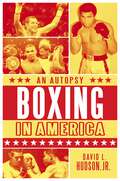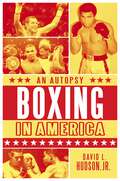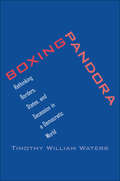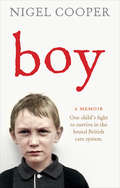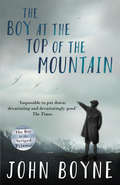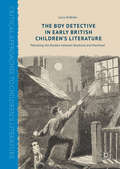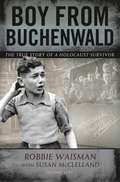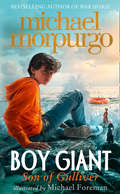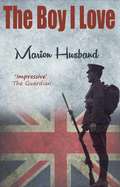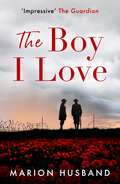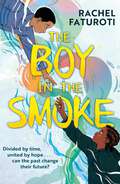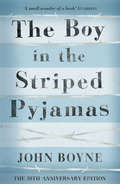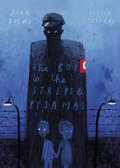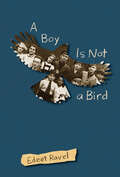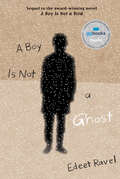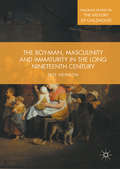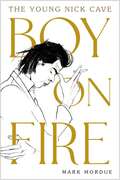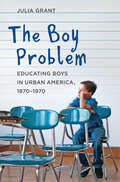- Table View
- List View
The Boxer's Story: Fighting for My Life in the Nazi Death Camps
by Nathan ShapowBefore 1940, Nathan Shapow, a young Latvian, had nothing more on his mind than enjoying his teenage years and becoming a champion boxer. But the Nazis’ systematic extermination of the Jews quickly put paid to his dreams. Soon he was to face a different sort of fight, where the prize for victory would be his life.Escaping certain death time and time again, Shapow saw his youth disappear in the terror of the Ghettos and the horror of the camps. Fighting for his very existence for the simple reason of being Jewish, remarkably, he survived, fell in love and forged a new life in what was then British-controlled Palestine. There, he joined an underground military organisation and quickly became involved in the struggle to create a Jewish state.Extraordinary and powerful, The Boxer’s Story is the inspiring true story of one man’s enduring fortitude.
Boxing in America: An Autopsy
by David L. Jr.This book presents a sweeping view of boxing in the United States and the influence of the sport on American culture.Boxing has long been a popular fixture of American sport and culture, despite its decidedly seedy side (the fact that numerous boxing champions acquired their skills in prison or reform schools, the corruption and greed of certain boxing promoters, and the involvement of the mob in fixing the outcome of many big fights). Yet boxing remains an iconic and widely popular spectator sport, even in light of its decline as a result of the recent burgeoning interest in mixed martial arts (MMA) contests. What had made this sport so enthralling to our nation for such a long period of time?This book contains much more than simple documentation of the significant dates, people, and bouts in the history of American boxing. It reveals why boxing became one of America's leading spectator sports at the turn of the century and examines the factors that have swayed the public's perception of it, thereby affecting its popularity. In Boxing in America, the author provides a compelling view of not only the pugilist sport, but also of our country, our sources of entertainment, and ourselves.
Boxing in America: An Autopsy
by David L. Jr.This book presents a sweeping view of boxing in the United States and the influence of the sport on American culture.Boxing has long been a popular fixture of American sport and culture, despite its decidedly seedy side (the fact that numerous boxing champions acquired their skills in prison or reform schools, the corruption and greed of certain boxing promoters, and the involvement of the mob in fixing the outcome of many big fights). Yet boxing remains an iconic and widely popular spectator sport, even in light of its decline as a result of the recent burgeoning interest in mixed martial arts (MMA) contests. What had made this sport so enthralling to our nation for such a long period of time?This book contains much more than simple documentation of the significant dates, people, and bouts in the history of American boxing. It reveals why boxing became one of America's leading spectator sports at the turn of the century and examines the factors that have swayed the public's perception of it, thereby affecting its popularity. In Boxing in America, the author provides a compelling view of not only the pugilist sport, but also of our country, our sources of entertainment, and ourselves.
Boxing Pandora: Rethinking Borders, States, and Secession in a Democratic World
by Timothy William WatersA timely and provocative challenge to the foundations of our global order: why should national borders be unchangeable? The inviolability of national borders is an unquestioned pillar of the post–World War II international order. Fixed borders are believed to encourage stability, promote pluralism, and discourage nationalism and intolerance. But do they? What if fixed borders create more problems than they solve, and what if permitting borders to change would create more stability and produce more just societies? Legal scholar Timothy Waters examines this possibility, showing how we arrived at a system of rigidly bordered states and how the real danger to peace is not the desire of people to form new states but the capacity of existing states to resist that desire, even with violence. He proposes a practical, democratically legitimate alternative: a right of secession. With crises ongoing in the United Kingdom, Spain, Ukraine, Iraq, Syria, Sudan, and many other regions, this reassessment of the foundations of our international order is more relevant than ever.
Boy: One Child's Fight to Survive in the Brutal British Care System
by Nigel Cooper“My parents had to try for eighteen months to conceive me, but my father was adamant he wanted one last child. After eighteen months of trying, my mother eventually conceived and nine months later I was born. My birth was a difficult one. It was like I was never meant to be in this world.” Boy is Nigel Cooper’s memoir from the age of five to sixteen. It tells the shocking, brutal, disturbing, emotional story of his childhood spent in and out of various care homes and institutions during the 1970s and 1980s. When Nigel was just seven years old, after the untimely death of his sister and father, his mother asked social services to take him away – and then his nightmare began. For the next nine years of his life, Nigel was repeatedly rejected by his mother and spent his childhood among bullies, abusers, psychopaths and criminals. He spent time in a children’s psychiatric hospital, where they carried out unimaginable tests, pumped him full of drugs and physically abused him; care homes, where he would come face to face with rough estate kids who would beat him up, force him to steal for them and threaten his life; and barbaric assessment centres for disturbed and delinquent children, where the staff were, at times, sicker than the children.The system tried to break Nigel and it was a miracle that he survived. The British care system robbed him of his childhood. His story is truly extraordinary and will do a lot more than shed light on what it was like growing up during the Jimmy Savile years.Boy is powerfully written, edgy, gripping and beautifully crafted.
A boy, a wolf, a legend for all time: Viper's Daughter, Skin Taker, Wolfbane: An omnibus edition
by Michelle PaverViper's DaughterFor two summers Torak and Renn have been living in the Forest with their faithful pack-brother, Wolf. But their happiness is shattered when Renn realises Torak is in danger – and she's the threat.Skin TakerIn the Dark Time of midwinter, disaster strikes the Forest. Chaos rules. Bears woken from their dens prowl the shadowy valleys. Desperate clans battle for survival. Only demons thrive. With their world in turmoil, Torak, Renn and Wolf are tested as never before. WolfbaneFleeing from a demon intent on devouring his souls, Wolf is swept out to Sea far from the Forest and his pack. The ocean teems with danger: sea wolves, sharks and hunters of the deep, and the demon is gaining ground. Torak and Renn must race to save their pack-brother. If they can't find Wolf in time, the bond between them will be severed for ever...
The Boy at the Top of the Mountain
by John BoyneWhen Pierrot becomes an orphan, he must leave his home in Paris for a new life with his Aunt Beatrix, a servant in a wealthy household at the top of the German mountains. But this is no ordinary time, for it is 1935 and the Second World War is fast approaching; and this is no ordinary house, for this is the Berghof, the home of Adolf Hitler. Quickly, Pierrot is taken under Hitler's wing, and is thrown into an increasingly dangerous new world: a world of terror, secrets and betrayal, from which he may never be able to escape.
The Boy Detective in Early British Children’s Literature: Patrolling the Borders between Boyhood and Manhood
by Lucy AndrewThis book maps the development of the boy detective in British children’s literature from the mid-nineteenth to the early-twentieth century. It explores how this liminal figure – a boy operating within a man’s world – addresses adult anxieties about boyhood and the boy’s transition to manhood. It investigates the literary, social and ideological significance of a vast array of popular detective narratives appearing in ‘penny dreadfuls’ and story papers which were aimed primarily at working-class boys. This study charts the relationship between developments in the representation of the fictional boy detective and changing expectations of and attitudes towards real-life British boys during a period where the boy’s role in the future of the Empire was a key concern. It emphasises the value of the early fictional boy detective as an ideological tool to condition boy readers to fulfil adult desires and expectations of what boyhood and, in the future, proper manhood should entail. It will be of particular importance to scholars working in the fields of children’s literature, crime fiction and popular culture.
The Boy Detective in Early British Children’s Literature: Patrolling the Borders between Boyhood and Manhood
by Lucy AndrewThis book maps the development of the boy detective in British children’s literature from the mid-nineteenth to the early-twentieth century. It explores how this liminal figure – a boy operating within a man’s world – addresses adult anxieties about boyhood and the boy’s transition to manhood. It investigates the literary, social and ideological significance of a vast array of popular detective narratives appearing in ‘penny dreadfuls’ and story papers which were aimed primarily at working-class boys. This study charts the relationship between developments in the representation of the fictional boy detective and changing expectations of and attitudes towards real-life British boys during a period where the boy’s role in the future of the Empire was a key concern. It emphasises the value of the early fictional boy detective as an ideological tool to condition boy readers to fulfil adult desires and expectations of what boyhood and, in the future, proper manhood should entail. It will be of particular importance to scholars working in the fields of children’s literature, crime fiction and popular culture.
Boy from Buchenwald
by Robbie Waisman Susan McClellandIt was 1945 and Romek Wajsman had just been liberated from Buchenwald, a brutal concentration camp where more than 60,000 people were killed. He was starving, tortured, and had no idea where his family was-let alone if they were alive. Along with 472 other boys, including Elie Wiesel, these teens were dubbed “The Buchenwald Boys.” They were angry at the world for their abuse, and turned to violence: stealing, fighting, and struggling for power. Everything changed for Romek and the other boys when Albert Einstein and Rabbi Herschel Schacter brought them to a home for rehabilitationRomek Wajsman, now Robbie Waisman, humanitarian and Canadian governor general award recipient, shares his remarkable story of transforming pain into resiliency and overcoming incredible loss to find incredible joy.
Boy Giant: Son Of Gulliver
by Michael MorpurgoA stunning new story of hope, humanity and high-seas adventure for children and adults everywhere from Sir Michael Morpurgo, the nation’s favourite storyteller and multi-million copy bestselling author of WAR HORSE.
The Boy Governor: Stevens T. Mason and the Birth of Michigan Politics
by Don FaberIn 1831, Stevens T. Mason was named Secretary of the Michigan Territory at the tender age of 19, two years before he could even vote. The youngest presidential appointee in American history, Mason quickly stamped his persona on Michigan life in large letters. After championing the territory's successful push for statehood without congressional authorization, he would defend his new state's border in open defiance of the country's political elite and then orchestrate its expansion through the annexation of the Upper Peninsula---all before his official election as Michigan's first governor at age 24, the youngest chief executive in any state's history. The Boy Governor tells the complete story of this dominant political figure in Michigan's early development. Capturing Mason's youthful idealism and visionary accomplishments, including his advocacy for a strong state university and legislating for the creation of the Soo Locks, this biography renders a vivid portrait of Michigan's first governor---his conflicts, his desires, and his sense of patriotism. This book will appeal to anyone with a love of American history and interest in the many, larger-than-life personalities that battled on the political stage during the Jacksonian era.
The Boy I Love: The Boy I Love: Book One (The Boy I Love Trilogy #1)
by Marion HusbandPaul Harris, still frail after shellshock, returns to his father’s home and to the arms of his secret lover, Adam. But when he discovers that Margot, the fiancée of his dead brother, is pregnant, Paul marries her through a sense of loyalty. He finds work as a teacher, sets up a home with Margot, but continues to see Adam.Pat Morgan who was a sergeant in Paul’s platoon runs a butcher’s shop in town, but can’t help yearning for the closeness he experienced with Paul in the trenches.Paul has to decide where his loyalty and his heart truly lies as all the characters search hungrily for the love and security denied them during the war.
The Boy I Love: The Boy I Love: Book One (The Boy I Love #1)
by Marion Husband'As with all the best novelists, Husband's talent seems to draw its energy from the experience of writing from perspectives far removed from her own as she inhabits other genders, other sexualities, other eras' Patrick Gale Lieutenant Paul Harris returns from the trenches to his father's home after suffering from shell shock. Paul's lover Adam awaits, but so too does Margot, the pregnant fiancée of his dead brother, whom Paul feels an obligation to care for. Forced to hide his true desires, Paul must decide where his loyalty and his heart lie.Set in the aftermath of World War I, Marion Husband's moving novel illuminates the difficulties faced in the post-war period by former soldiers, and explores early twentieth-century taboos, love and betrayal. Through vivid flashbacks, effortless prose and realistic dialect, 'the love that dare not speak its name' is explored with true feeling and passion. Exploring the prejudice of only a few generations ago, The Boy I Love is a classic love story.Just some of the amazing GOODREADS REVIEWS:'A beautiful, melancholy book which feels terribly true to its time and to the characters.''A wonderful book. One of those that I just couldn't put down.''I absolutely loved this book. Found it utterly unputdownable.'
A Boy in the House
by Mazo de la RocheFrom the author of the bestselling Jalna series! Writing in isolation was never trickier than in this full house. In this short but poignant tale, Mazo de la Roche tells the story of a small boy from an orphan home who has come to work for two sisters — Mrs Morton and Lydia Dove — who are, in old age, suffering greatly reduced circumstances. They have rented out half of their house to a writer, Lindley, who has sought out this isolated spot for the writing of a novel. However, the seclusion promised him is broken by strange and frightening events. The sisters’ struggle over the boy, Lindley’s love for the boy, his efforts to keep himself aloof for the writing of his book, are related by Mazo de la Roche with that complete belief in her characters which makes them live for the reader.
The Boy in the Smoke
by Rachel FaturotiDivided by time, united by hope... can the past change their future?From the acclaimed author of Sadé and her Shadow Beasts comes a brand new story - about a boy and his dad dealing with the threat of eviction and a boy from the past who might be able to help ... perfect for fans of A Kind of Spark.Isaiah always has an easy smile and smart answer for his teachers. He's good at fixing things and making people happy. But ever since Mum left and Dad got ill, it's been getting harder to keep all that up. To not let his friends know they're struggling. To keep believing things will get better...Then Isaiah meets the boy in the smoke, a boy he connects with through a forgotten fireplace in his tower block. A boy from the past with a mystery to solve, who desperately needs Isaiah's help.Can Isaiah change Jacob's life for the better? And in doing so, maybe can he change his own?An uplifting story about friendship and resilience, courage and hope...
The Boy in the Striped Pyjamas (Rollercoasters Ser.)
by John BoyneLines may divide us, but hope will unite us. Nine year old Bruno knows nothing of the Final Solution and the Holocaust. He’s oblivious to the appalling cruelties being inflicted on the people of Europe by his country. All he knows is that he has moved from Berlin to a desolate area where he has no one to play with.Until he meets Shmuel. Shmuel lives in a strange parallel existence on the other side of the adjoining wire fence, where everyone wears a uniform of striped pyjamas. Despite the wire fence separating them, the two boys become best friends. As they grow closer, Bruno starts to learn the terrible truth that lies beyond the fence, and what life is like for his friend. John Boyne’s classic novel explores the friendship and loss of innocence of Bruno and Shmuel, during one of the worst points in history.
The Boy in the Striped Pyjamas (Rollercoasters Ser.)
by John BoyneBruno doesn't like his new house. He had to leave all his friends behind in Berlin, and there are no children to play with here - until Bruno meets Shmuel, a boy who lives on the other side of the wire fence near Bruno's house, and who wears a strange uniform of striped pyjamas.A stunning anniversary edition of John Boyne's powerful classic bestseller, with illustrations from award-winning artist Oliver Jeffers.
A Boy Is Not a Bird
by Edeet RavelA young boy named Natt finds his world overturned when his family is uprooted and exiled to Siberia during the occupation of the Soviet Ukraine by Nazi Germany. In 1941, life in Natt’s small town of Zastavna is comfortable and familiar, even if the grownups are acting strange, and his parents treat him like a baby. Natt knows there’s a war on, of course, but he’s glad their family didn’t emigrate to Canada when they had a chance. His mother didn’t want to leave their home, and neither did he. He especially wouldn’t want to leave his best friend, Max. Max is the ideas guy, and he hears what’s going on in the world from his older sisters. Together the boys are two brave musketeers. Then one day Natt goes home and finds his family huddled around the radio. The Russians are taking over. The churches and synagogues will close, Hebrew school will be held in secret, and there are tanks and soldiers in the street. But it’s exciting, too. Natt wants to become a Young Pioneer, to show outstanding revolutionary spirit and make their new leader, Comrade Stalin, proud. But life under the Russians is hard. The soldiers are poor. They eat up all the food and they even take over Natt’s house. Then Natt’s father is arrested, and even Natt is detained and questioned. He feels like a nomad, sleeping at other people’s houses while his mother works to free his father. As the adults try to protect him from the reality of their situation, and local authorities begin to round up deportees bound for Siberia, Natt is filled with a sense of guilt and grief. Why wasn’t he brave enough to look up at the prison window when his mother took him to see his father for what might be the last time? Or can just getting through war be a heroic act in itself? Key Text Features historical note map author’s note Correlates to the Common Core State Standards in English Language Arts: CCSS.ELA-LITERACY.RL.6.3 Describe how a particular story's or drama's plot unfolds in a series of episodes as well as how the characters respond or change as the plot moves toward a resolution.
A Boy Is Not a Ghost
by Edeet RavelIn this sequel to the award-winning A Boy Is Not a Bird, a boy is exiled to Siberia during World War II. Based on a true story. Torn from his home in Eastern Europe, with his father imprisoned in a Siberian gulag, twelve-year-old Natt finds himself stranded with other deportees in a schoolyard in Novosibirsk. And he is about to discover that life can indeed get worse than the horrific two months he and his mother have spent being transported on a bug-infested livestock train. He needs to write to his best friend, Max, but he knows the Soviet police reads everyone’s mail. So Natt decides to write in code, and his letters are a lifeline, even though he never knows whether Max will receive them. Every day becomes a question of survival, and where they might be shunted to next. When his mother is falsely arrested for stealing potatoes, Natt is truly on his own and must learn how to live the uncertain life of an exile. Practice being invisible as a ghost, change your name and identity if you have to, watch out for spies, and never draw the attention of the authorities. Even then, he will need luck on his side if he is ever going to be reunited with his family. Key Text Features author's note Illustrations map Correlates to the Common Core State Standards in English Language Arts: CCSS.ELA-LITERACY.RL.4.3 Describe in depth a character, setting, or event in a story or drama, drawing on specific details in the text (e.g., a character's thoughts, words, or actions). CCSS.ELA-LITERACY.RL.5.3 Compare and contrast two or more characters, settings, or events in a story or drama, drawing on specific details in the text (e.g., how characters interact). CCSS.ELA-LITERACY.RL.5.4 Determine the meaning of words and phrases as they are used in a text, including figurative language such as metaphors and similes. CCSS.ELA-LITERACY.RL.5.6 Describe how a narrator's or speaker's point of view influences how events are described. CCSS.ELA-LITERACY.RL.5.7 Analyze how visual and multimedia elements contribute to the meaning, tone, or beauty of a text (e.g., graphic novel, multimedia presentation of fiction, folktale, myth, poem).
The Boy King: Legends of Camelot 2 (Arthur the Hero – Book II) (Arthur the Hero #2)
by Jack WhyteAn heir hiddenA land dividedA king in waitingHaving fled their home of Camelot, Merlyn Britannicus and the Arthur Pendragon find sanctuary in an abandoned Roman fort as the protector continues the young heir's training.Sheltered from the forces that would destroy him, Arthur grows in strength and resolve, and the child becomes a warrior and a hero.But a storm is coming, and Merlyn must make preparations for the path ahead: a dangerous journey home and the battle that will see the boy become a king.Discover the most authentic telling of the Arthurian legend ever written
The Boy Made of Snow
by Chloe Mayer'A haunting and thrilling read' Kate Hamer, author of The Girl in the Red Coat'Original and unsettling - and just a little bit heartbreaking' Rachel Rhys, author of Dangerous CrossingIn a sleepy English village in 1944, Annabel and her son Daniel live in the shadow of war. With her husband away, an increasingly isolated Annabel begins to lose her grip on reality.When mother and son befriend Hans, a German PoW consigned to a nearby farm, their lives are suddenly filled with thrilling secrets. To Annabel, Hans is an awakening from the darkness that has engulfed her since Daniel's birth. To her son, a solitary boy caught up in the magical world of fairy tales, he is perhaps a prince in disguise. But Hans has plans of his own and will soon set them into motion with devastating consequences.
The Boy-Man, Masculinity and Immaturity in the Long Nineteenth Century (Palgrave Studies in the History of Childhood)
by Pete NewbonThis book explores the evolution of male writers marked by peculiar traits of childlike immaturity. The ‘Boy-Man’ emerged from the nexus of Rousseau’s counter-Enlightenment cultural primitivism, Sensibility’s ‘Man of Feeling’, the Chattertonian poet maudit, and the Romantic idealisation of childhood. The Romantic era saw the proliferation of boy-men, who congregated around such metropolitan institutions as The London Magazine. These included John Keats, Leigh Hunt, Charles Lamb, Hartley Coleridge, Thomas De Quincey and Thomas Hood. In the period of the French Revolution, terms of childishness were used against such writers as Wordsworth, Keats, Hunt and Lamb as a tool of political satire. Yet boy-men writers conversely used their amphibian child-adult literary personae to critique the masculinist ideologies of their era. However, the growing cultural and political conservatism of the nineteenth century, and the emergence of a canon of serious literature, inculcated the relegation of the boy-men from the republic of letters.
Boy on Fire: The Young Nick Cave
by Mark MordueAn intensely beautiful, profound and poetic biography of the formative years of the dark prince of rock 'n' roll, Boy on Fire is Nick Cave's creation story, a portrait of the artist first as a boy, then as a young man. A deeply insightful work which charts his family, friends, influences, milieu and, most of all, his music, it reveals how Nick Cave shaped himself into the extraordinary artist he would become.A powerful account of a singular, uncompromising artist, Boy on Fire is also a vivid and evocative rendering of a time and place, from the fast-running dark rivers and ghost gums of country-town Australia to the torn wallpaper, sticky carpet and manic energy of the nascent punk scene which hit staid 1970s Melbourne like an atom bomb. Boy on Fire is a stunning biographical achievement.
The Boy Problem: Educating Boys in Urban America, 1870–1970
by Julia GrantAmerica’s educational system has a problem with boys, and it’s nothing new.The question of what to do with boys—the "boy problem"—has vexed educators and social commentators for more than a century. Contemporary debates about poor academic performance of boys, especially those of color, point to a myriad of reasons: inadequate and punitive schools, broken families, poverty, and cultural conflicts. Julia Grant offers a historical perspective on these debates and reveals that it is a perennial issue in American schooling that says much about gender and education today.Since the birth of compulsory schooling, educators have contended with what exactly to do with boys of immigrant, poor, minority backgrounds. Initially, public schools developed vocational education and organized athletics and technical schools as well as evening and summer continuation schools in response to the concern that the American culture of masculinity devalued academic success in school. Urban educators sought ways to deal with the "bad boys"—almost exclusively poor, immigrant, or migrant—who skipped school, exhibited behavioral problems when they attended, and sometimes landed in special education classes and reformatory institutions. The problems these boys posed led to accommodations in public education and juvenile justice system.This historical study sheds light on contemporary concerns over the academic performance of boys of color who now flounder in school or languish in the juvenile justice system. Grant's cogent analysis will interest education policy-makers and educators, as well as scholars of the history of education, childhood, gender studies, American studies, and urban history.

